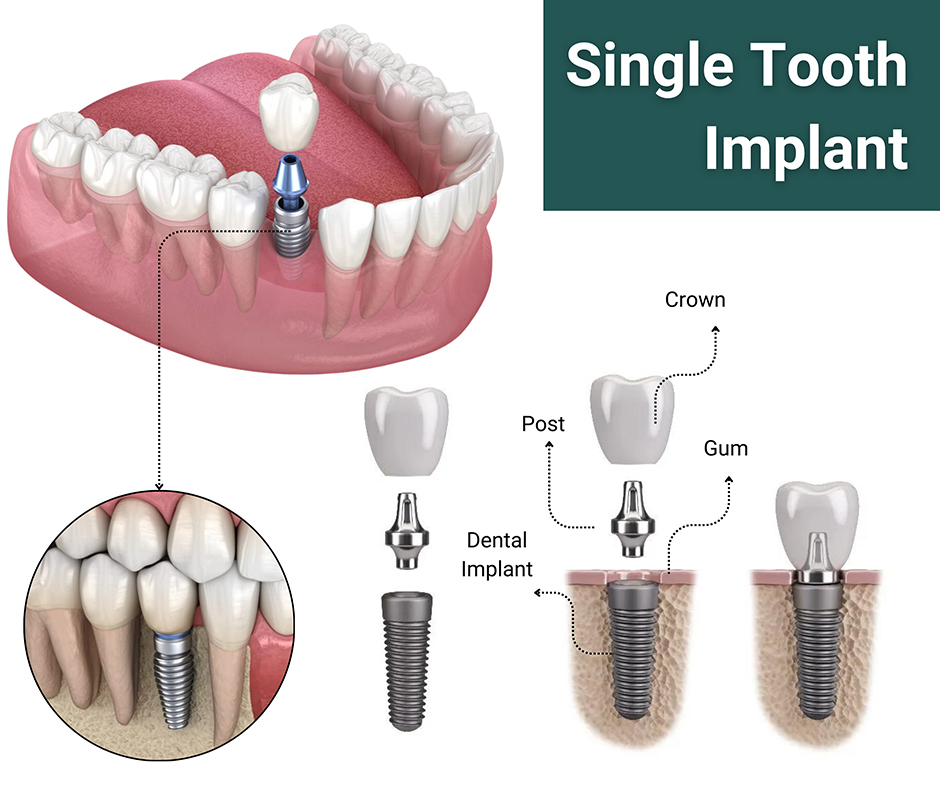Dental Implants Fundamentals Explained
Table of ContentsExamine This Report on Dental ImplantsUnknown Facts About Dental ImplantsDental Implants - QuestionsExcitement About Dental Implants
are clinical tools operatively dental implanted into the jaw to recover a person's ability to eat or their look. They offer assistance for synthetic (phony) teeth, such as crowns, bridges, or dentures. When a tooth is shed due to injury or illness, an individual can experience complications such as rapid bone loss, faulty speech, or adjustments to eating patterns that result in discomfort.
Structure of The Oral Implant System selecting dental implants, talk with your oral copyright concerning the prospective benefits and dangers, and whether you are a candidate for the procedure. Points to take into consideration: Your total health and wellness is a crucial aspect in determining whether you are a good candidate for dental implants, for how long it will certainly require to recover, and how long the implant might remain in place.
Smoking may influence the healing process and lower the long-lasting success of the dental implant. The recovery process for the dental implant body may take a number of months or longer, throughout which time you typically have a short-lived abutment instead of the tooth. the dental implant treatment: Thoroughly follow the dental hygiene guidelines offered to you by your oral copyright.
Our Dental Implants Diaries
Implant failing can cause the need for one more operation to repair or change the dental implant system. Recovers the ability to chew Brings back aesthetic appearance Helps maintain the jawbone from reducing as a result of bone loss Protects the health of the bordering bone and gum tissues Aids keep nearby (nearby) teeth stable Improves quality of life Damage to bordering all-natural teeth throughout dental implant placement Injury to the surrounding tissues during surgical treatment, such as sinus opening Injury throughout surgical procedure (as an example, fracture of surrounding jawbone) Poor function, such as seeming like the teeth do not attack together typically A feeling that the tooth is loose or twisting in position arising from a joint screw loosening up Implant body failure (looseness of the implant body) due to systemic infection, which might be more probable in patients with uncontrolled diabetes mellitus due to local infection in bone and gums supporting the dental implant body as a result of postponed healing, a fantastic read which might be more likely in clients that smoke Trouble cleansing the gums around the implant, leading to bad oral hygiene Unattended gum condition Post-surgical tingling because of nerve impingement or damage Always inform healthcare suppliers and imaging service technicians that you have oral implants before any type of magnetic resonance imaging (MRI) or x-ray treatments.
FDA is not knowledgeable about any type of adverse events reported for MRI or x-ray treatments with dental implants. Oral implants systems are normally made of products that follow worldwide agreement standards of the International Company for Standardization (ISO) or ASTM International. These criteria have details of what makes a secure material.
Oral dental implant systems are reviewed according to international consensus standards. Biocompatibility testing, to show that physical call with the device does not cause problems like inflammation or allergic reaction, is component of the evaluation that helps guarantee the materials in the oral implant system are secure and do not create adverse impacts when dental implanted in people.

Indicators on Dental Implants You Should Know
Some individuals are not eligible for dental implant surgical procedure. It is for dental doctors to operate individuals with: severe illnessuncontrollable metabolic diseasebone or soft tissue condition or infectionIf these issues are fixed, a person can have the surgery. Dental Implants. In, dental cosmetic surgeons refrain from running on individuals with: If individuals with any one of the above undergo a fantastic read dental implant surgery, there is a greater danger of the implant failing
Some individuals have a jawbone abnormality that prevents enough bone for an click here to read implant from developing. The cosmetic surgeon will certainly after that utilize a bone or bone substitute to fix and develop up the location.
Oral implant surgical treatment is a customized procedure. It's not the exact same for every person. The complying with provides a basic overview of what you can anticipate your dental expert, oral specialist, periodontist or prosthodontist to do: Position the implant surgically. Give you time to recover. Affix the post and final crown, bridge or denture.
Next off, your surgeon will carefully position the dental implant right into your jaw. If your dental implant is near the front of your mouth, your dental professional will make a momentary tooth for you to put on up until you heal.
9 Easy Facts About Dental Implants Explained
Your provider can tell you what to anticipate in your circumstance. During the recovery phase, your jawbone must fuse to the oral implant. This process, called osseointegration, is important for security and long-lasting success. This process can take anywhere from three to nine months. In many cases, it might take longer.
Once your implant heals, your dental professional can connect the abutment (small connector post) and your final remediation (crown, bridge or denture). This generally takes regarding one hour to finish and might require a second small surgical procedure. You shouldn't feel any discomfort during your dental implant procedure due to the fact that your copyright will use drug to numb your periodontals.